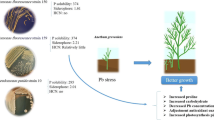Abstract
Objectives
To evaluate Pseudomonas monteilii strain PN1 for the removal efficiency of P-nitrophenol (PNP) in soils and its growth promotion of maize (Zea mays L.) seedlings under drought and saline–alkali stress.
Results
PN1 can survive in soils contaminated with PNP dosage between 90 and 155 mg/kg and considerably improved the removal PNP efficiency in soils. Drought and saline–alkali stress reduced maize seedling growth (root length, shoot height and dry or fresh weight) and improved the antioxidant enzyme activities and malondialdehyde (MDA) and proline (PRO) contents. However, maize seedlings treated with PN1 remarkably promoted their growth compared with the control. The reduction in antioxidant enzyme activities and MDA and PRO contents was significant. This result may be correlated to the increased tolerance of maize seedlings to drought and saline–alkali stress.
Conclusions
Application of P. monteilii PN1 can be an extremely useful approach for the development of bioinoculants in improving plant tolerance to several abiotic stresses and removing PNP in soils to ensure secure crop production.







Similar content being viewed by others
References
Amico ED, Cavalca L, Andreoni V (2008) Improvement of Brassica napus growth under cadmium stress bycadmium-resistant rhizobacteria. Soil Bio Biochem 40:74–84
Bates LS, Waldren RP, Teare ID (1973) Rapid determination of free proline for water stress studies. Plant Sci 39:205–207
Carter MR (1993) Soil sampling and methods of analysis. CRC, Florida
Chaudhry V, Bhatia A, Bharti SK, Mishra SK, Chauhan PS, Mishra A, Sidhu OP, Nautiyal CS (2015) Metabolite profiling reveals abiotic stress tolerance in Tn5 mutant of Pseudomonas putida. PLoS ONE 10(1):e0113487
Dekkers LC, Mulders IHM, Phoelich CC, Chin-A-Woeng TFC, Wijfjes AHM, Lugtenberg BJJ (2000) The sss colonization gene of the tomato-Fusarium oxysporum f. sp. radicis-lycopersici biocontrol strain Pseudomonas fluorescens WCS365 can improve root colonization of other wild-type Pseudomonas spp. bacteria. Mol Plant Microbe Interact 13:1177–1183
Garcíaa JE, Maroniche G, Creusb C, Suárez-Rodríguezd R, Ramirez-Trujillod JA, Groppae MD (2017) In vitro PGPR properties and osmotic tolerance of different Azospirillum native strains and their effects on growth of maize under drought stress. Microbiol Res 202:21–29
Guifang G, Youshao W, Hao C, Zhaoyu J, Jiao F (2015) Physiological and biochemical response to drought stress in the leaves of Aegiceras corniculatum and Kandelia obovata. Ecotoxicology 24:1668–1676
Hejun R, Cong W (2016) Isolation of a para-nitrophenol degrading bacterium and characterization of its plant growth-promoting properties. Sci Technol Rev 34(2):231–236
Jingshun Z, Zhongtao S, Yingying L, Xiang P, Wen L, Yanchun Y (2009) Biodegradation of p-nitrophenol by Rhodococcus sp. CN6 with high cell surface hydrophobicity. J Hazard Mater 163:723–728
Jun M, Bin W, Xiaoke H (2017) Effect of inoculation of Burkholderia sp. strain SJ98 on bacterial community dynamics and para-nitrophenol, 3-methyl-4-nitrophenol, and 2-chloro-4-nitrophenol degradation in soil. Sci Rep 7:5983
Kataria S, Baghel L, Guruprasad KN (2017) Pretreatment of seeds with static magnetic field improves germination and early growth characteristics under salt stress in maize and soybean. Biocatal Agric Biotechnol 10:83–90
Lei Z, Yunpeng H, Lichun W (2018) Effect of alkaline salt stress on plant and method of enhancing saline-alkali resistance. J Northeast Agric Sci 43(4):11–16
Mohammadkhani N, Heidari R (2007) Effects of drought stress on protective enzyme activities and lipid peroxidation in two maize cultivars. Pak J Biol Sci 10:3835–3840
Naqqash T, Hameed S, Imran A, Hanif MK, Majeed A, van Elsas JD (2016) Differential response of potato toward inoculation with taxonomically diverse plant growth promoting rhizobacteria. Front Plant Sci 7:144
Samaddar S, Chatterjee P, Choudhury AR, Ahmed S, Sa T (2019) Interactions between Pseudomonas spp. and their role in improving the red pepper plant growth under salinity stress. Microbiol Res 219:66–73
Sandhya V, Ali SZ, Venkateswarlu B, Reddy G, Minakshi G (2010) Effect of osmotic stress on plant growth promoting Pseudomonas spp. Arch Microbiol 192:867–876
Sangmo K, Ramalingam R, Abdul LK, MinJi K, Park Jaeman, Bora K, Donghyun S, Injung L (2014) Gibberellin secreting rhizobacterium, Pseudomonas putida H-2-3 modulates the hormonal and stress physiology of soybean to improve the plant growth under saline and drought conditions. Plant Physiol Biochem 84:115–124
Shiferaw B, Prasanna BM, Hellin J, Bänziger M (2011) Crops that feed the world 6. Past successes and future challenges to the role played by maize in global food security. Food Secur 3(3):307
Shuang L (2016) Effect of soil enzymes and microorganisms on organic carbon and inorganic carbon of saline-alkali farmland soil in western Jilin Province. Jilin University, Changchun
Vurukonda SSKP, Vardharajula S, Shrivastava M, SkZ A (2016) Multifunctional Pseudomonas putida strain FBKV2 fromarid rhizosphere soil and its growth promotional effects on maize under drought stress. Rhizosphere 1:4–13
Wani AS, Ahmad A, Hayat S, Tahir I (2019) Epibrassinolide and proline alleviate the photosynthetic and yield inhibition under salt stress by acting on antioxidant system in mustard. Plant Physiol Biochem 135:385–394
Wei L, Yingyu H, Menxin W, Li W (2017) Validation and adaptability evaluation of WOFOST model in spring maize area of northeast. Meteor Environ Sci 40(3):7–13
Wei L, Yijun L, Liang H, Yingbo S (2018) Effect of growing season drought on spring maize yields in Northeast China based on standardized precipitation index. Trans Chin Soc Agric Eng 34(22):121–127
Acknowledgements
This work was supported by the National Key Research and Development Program of China (Grant No. 2017YFD0201606) and the National Natural Science Foundation of China (Grant No. 31572031).
Author information
Authors and Affiliations
Corresponding author
Additional information
Publisher's Note
Springer Nature remains neutral with regard to jurisdictional claims in published maps and institutional affiliations.
Rights and permissions
About this article
Cite this article
Zhang, Y., Yang, F., Ren, H. et al. Pseudomonas monteilii PN1: a great potential P-nitrophenol degrader with plant growth promoting traits under drought and saline–alkali stresses. Biotechnol Lett 41, 801–811 (2019). https://doi.org/10.1007/s10529-019-02692-4
Received:
Accepted:
Published:
Issue Date:
DOI: https://doi.org/10.1007/s10529-019-02692-4




